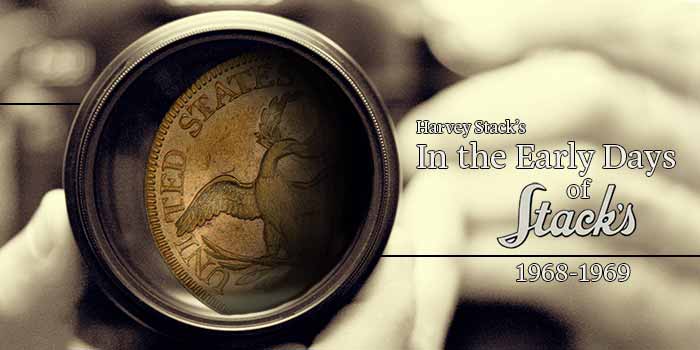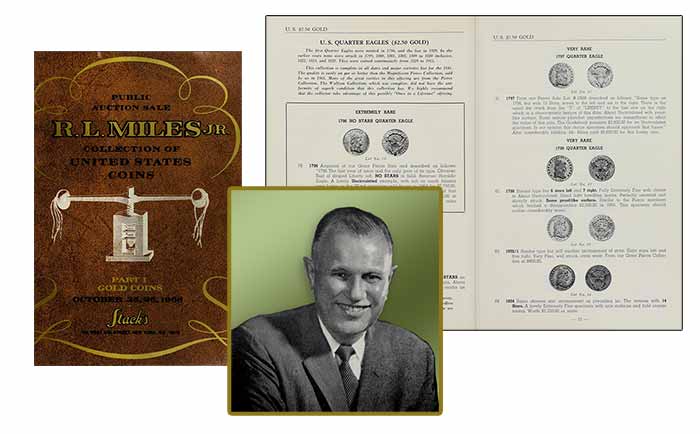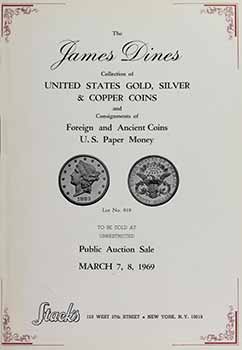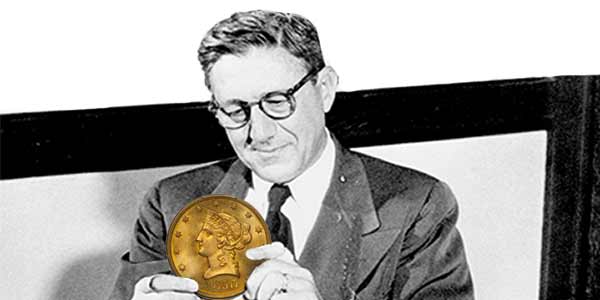
By Harvey Stack – Co-Founder, Stack’s Bowers Galleries ……
The R.L. Miles Collection, Part 1
The October 1968 R.L. Miles Collection feeatured a large and almost complete selection of U.S. Gold, one of the most extensive offerings–in both quality and examples offered–in a single collection during the decades after World War II.
It had a wide range of rarities, carefully selected by “Skinny” (Mr. Miles) or by members of Stack’s who guided him in finding the coins for his collection at the right price. It was another “dream collection” for Stack’s to build and then sell at public auction.
An outline of his Gold Coin Collection is listed below and the quality he desired was not always easy to find. The overall collection had many Mint State examples, others with just the slightest wear, and (when possible) Proof coins filled out his collection. All of these factors made it so desirable for others to try to acquire examples from it.

For this portion of the sale Stack’s rented the Manhattan Skyline Suite of the newly renovated Hotel Park Sheraton located near Stack’s – a large roof-top sales room that could readily handle some 300 buyers. And because of the vastness and scope of the Miles Gold Coin collection, the sale had many moments that were “Standing Room Only”. The activity was astounding.
Here are some of the highlights:
GOLD DOLLARS ($1.00 GOLD). A virtually complete set, with the Rare Mints of C and D, and very choice Mint State and Proofs.
QUARTER EAGLES ($2.50 GOLD). An outstanding offering, which includes both varieties of 1796, all the early dates to 1807, 1804, 1848 CAL, 1854-S, and 1875 to list but a few of the rarities.
THREE DOLLAR GOLD ($3.00). A virtually complete set, lacking only the unique 1870-S, with super highlights in both Mint State and Proof. Featuring the 1854-D, 1875 and 1876 (one of the last coins he acquired was from our Samuel Wolfson Sale a few year earlier was the 1875 Proof, which, as I was representing him at the sale, he had to pay a whopping $16,500 for, a record for the period. But since I had the orders “DON’T LOSE IT”, I had to go to the limit!

HALF EAGLES ($5.00 GOLD) 1795-1929. The series starts with both varieties of 1795, three different die arrangements of 1797, 1825, 1826, 1830, 1832, 1833, all the C and D mints, 1876, 1929, and most dates in between, many in Mint State and Proof.
EAGLES ($10.00 GOLD) 1795-1933. Beginning in 1795, having all the dates and varieties through 1804, including both varieties of 1798, most of the O and CC mints, a superb 1907 Rolled Edge Indian Head, 1920-S, 1930-S and 1933 – all in high grades, mostly Mint State or Proof.
DOUBLE EAGLES ($20,00 GOLD). Including 1854-O, 1856-O, 1871-CC, 1879-O, 1887, 1920-S, 1921, 1925-D, 1925-S, 1926-D, 1926-S, l927-S, 1929, 1930-S, 1931, 1931-D, and 1932. A MAJOR COLLECTION, with many in Mint State or high grade.
The entire gold coin collection was a feature in the gold coin market for 1968 and for many years earlier, elevating the value of these gold coin series in the overall marketplace.
Stack’s sold the COPPER, SILVER and NICKEL COINS in 1969, during the Metropolitan New York Numismatic Convention in the spring of that year.
With having the major public auction sales during the year, attending many conventions and shows, able to reignite our foreign gold coin business, spending hours and days helping the Smithsonian with the Lilly coins, developing new collectors who started to build major collections, handling the daily trade of silver bulk coins from change, altogether made the operation of Stack’s busy and had little time for our families. They understood, and worked with us in the office whenever they could. We were growing fast, and wanted to be sure to keep it that way.
1969 – A Year of Transition
So many things came together in 1969.
As gold and silver advanced in price, speculation in precious metals became the “hobby of the times”. Silver coins found in circulation (dated 1954 and earlier) grew in value, so that each coin was worth more than face value. A silver dime was worth almost $1.00, a quarter $2.50 and a half dollar became valued at $5.00. The press was constantly reporting on this premium, and so, for the public at large as well as the for the collector, the hunt was on.
By 1968 the United States Treasury Department said it would “allow” coins to be melted (something that was illegal before), and the public went nuts. Even the silverware was fair game.
In addition, Whitman Publications, purveyors of the annual Red Book, went into full production of inexpensive booklets designed for virtually every denomination except gold and going back as far as the first year of issue. They labeled each opening with the date, mint mark and number struck, and sold these to the collecting public at less than 50 cents each. These albums made for a great family activity, especially when the seniors came home with a lot of change in their pockets.
The market for numismatic items grew more rapidly, for now one could collect gold coins as well as make a profit on silver coins. Demand increased and values rose quickly. The number of collectors who where now active increased substantially. The American Numismatic Association, as well as numerous clubs around the country, grew as coin collecting became much more popular.
Of course this increase in demand, and the public recognition of coins as a hobby, made the industry grow. New dealers entered the business, and older firms like Stack’s were part of the increased growth. Our retail shop on 57th Street in New York attracted many, remaining as a “clubhouse” for old- and new-time collectors to gather, buy coins or sell some, attend one of our monthly weekend auctions, or just come by and chat with friends that they met while visiting Stack’s.
We started our 1969 auctions with an offering of United States gold, silver and copper coins in all grades and highlights for the general collector. These were smaller groupings, including a specialized encased postage collection (which was also sought after by stamp collectors). That sale consisted of some 1,138 lots and was sold in January 1969.
 We auctioned the James Dine Collection of United States gold and silver coins in March. For those who do not recognize the name, James Dines in the 1950s and ’60s was a prominent financial advisor who was quoted in newspapers and on the radio. He started collecting after he inherited his father’s coins. The James Dine sale had 1,119 lots, consisting of some 469 lots of foreign and ancient gold and silver, which was the background he used to traced monetary history during its 2,500 years of development.
We auctioned the James Dine Collection of United States gold and silver coins in March. For those who do not recognize the name, James Dines in the 1950s and ’60s was a prominent financial advisor who was quoted in newspapers and on the radio. He started collecting after he inherited his father’s coins. The James Dine sale had 1,119 lots, consisting of some 469 lots of foreign and ancient gold and silver, which was the background he used to traced monetary history during its 2,500 years of development.
He personally liked U.S. coins, which he started assembling as a Type Set so he could be familiar with the various designs and weights that were part of his study of American monetary issues. He also amassed collections of dates and mints of some series (usually in Mint State or Proof), from the half cent to the $20 gold double eagle, which he found to be a challenge. His U.S. coins made 650 lots, and the public had the opportunity to learn from his hobby.
The R.L. Miles Collection, Part 2
We held the major sale of the year in conjunction with the Metropolitan New York Numismatic Convention in April: the R.L. Miles Collection of United States copper coins.
Collectors who knew “Skinny” and had seen his collection on display knew that this portion of his collection was a great opportunity to acquire choice and rare coins that had eluded them in the past.
Realizing that attendance would be high, we decided to take the largest ballroom in the Park Sheraton Hotel to hold the sale. The Main Ballroom, located on the lower level of the hotel, could readily seat 400 to 500 people in theatre style. Considering our pre-sale exhibit had attracted hundreds of viewers, and the sale was part of the largest regional convention in the East, we set up some 400 chairs.
The collection attracted so many bidders that we had 100 more (500 in all) seats set up, but as the sale progressed it was strictly standing room only.
What attracted so many bidders?
When one sells a virtually complete set of United States copper and silver coins in outstanding condition, and many of the coins come from pedigree collections from decades before, it’s an opportunity that rarely occurs. To own a MILES COIN attracted the crowd!
 Miles was well acquainted with the Eliasberg Collection, and actively sought to emulate it. He went to Baltimore (not too far from Norfolk) whenever the Eliasberg Collection went on displayto examine it. He met Louis Eliasberg on several visits and the friendship stimulated him in his collecting endeavors. Of course, Eliasberg had a few unique coins or almost unique ones, so “Skinny” would have to wait for them to come to market.
Miles was well acquainted with the Eliasberg Collection, and actively sought to emulate it. He went to Baltimore (not too far from Norfolk) whenever the Eliasberg Collection went on displayto examine it. He met Louis Eliasberg on several visits and the friendship stimulated him in his collecting endeavors. Of course, Eliasberg had a few unique coins or almost unique ones, so “Skinny” would have to wait for them to come to market.
But the challenge was there, and he took it.
Following are some of the highlights that were sold:
HALF CENTS (1793-1857). A comprehensive date set, with the following highlights in mostly Mint State: 1793, 1796 Pole to Cap; and most of the Proofs from 1831 to 1857, both originals and restrikes.
LARGE CENTS (1793-1857). A date run in very high grades, highlighted by all three designs of 1793, l794 with Mint State and later Proof examples.
MINOR COINS. Small cents (1856 -1947) with mostly Proofs featuring 1856, 1857, 1858, 1864 “L”, and 1877 to mention but a few. TWO CENTS. THREE CENT NICKEL and SILVER, and FIVE CENTS, with the early issues in Brilliant Proof and others in choice Mint State.
HALF DIMES. Virtually a full set, 1794-1873, from almost Mint State or beautiful condition. Included early Proofs and one of the finest assemblages of New Orleans (O-mint) of this important series. He included in his collection the 1859 Type of 1860 as well.
DIMES (1796-1946). All dates and mints, mostly Mint State or glittering Proofs. Again, the early types were extremely choice, the O-mints were of gem quality, and the Proofs started from 1855 and were complete. Even the famous dime collector Allen Lovejoy, whose collection wWe helped build and sell in later years, found a number of pieces from the Miles Collection to add to his. Only one was missing in the offering: the 1894-S.
TWENTY CENT PIECES. 1875-1878, in Gem Brilliant Proof, or superb Mint State. Included the Very Rare 1876-CC.
QUARTER DOLLARS. Another almost complete set, from 1796 to 1947, mostly Mint State and highlighted by such rarities as 1796, 1804, 1823/2, 1827 (both an original and a restrike), 1842-O small date in Proof, a Mint State 1853/2 No Arrows, l878-S, PROOFS from 1854 to date, and exceptional Proof and Mint State examples in the Barber and Liberty Standing series. A wonderful collection.
HALF DOLLARS (1794-1947). Virtually all dates and mints. One of the favorite series that R. L. Miles assembled. The rarities included Mint State 1794, 1795, l796 both varieties, 1797, l80l, and an extensive run of dates and subvarieties of the bust series.
The Liberty series was complete with Proofs starting 1855 and including the great rarity 1878-S, a superb collection of CC-mints, and a full run of both the Barber and Liberty Standing series in outstanding Proof and Mint State. Specialized collectors of die varieties had a wonderful opportunity to obtain some of the rarer, seldom-seen coins of this entire series.
SILVER DOLLARS (1794-1935); TRADE DOLLARS (1873-1883). An outstanding offering, with highlights like 1794, and many of the early varieties. A Unique offering of Gobrecht dollars: eight different dates and varieties in outstanding condition, 1851, 1852, 1858, the rare 1870-S, and a complete collection of Morgan and Peace dollars. Followed by an outstanding collection of trade dollars. This series was one of the best collections to be offered in the market in decades.
The New York Convention had a record crowd attending, many traveling from far away to attend and bid on this rare and unusual auction. This sale was considered a landmark, and it had a positive impact on the hobby.
Other Stack’s Auctions in 1969
In May, Stack’s offered the Illinois Collection, a comprehensive assemblage of ancient, foreign and United States gold coins, consisting of some 1,011 attractive numismatic lots.
June brought to market a fabulous collection of Greek and Roman gold, silver and bronze coins assembled by Fred V. Fowler, which was assembled over four decades from some major collections offered earlier in the 20th century. Fowler’s collection contained over 1,200 lots of ancient coins, tracing the history of early Greek and Roman monetary history. Among the highlights of the 347 early Greek series were a Dekadrachm of Syracuse, a Decadrachm of Carthage, a coin from the First Revolt of Judea, and a 1 1/2 Gold Stater of Carthage.
The Roman section, 420 lots, traced the history of the Roman Republic, the Roman Empire and the Byzantine world. All the emperors were represented; many in gold and others in silver.
In September we offered the extensive collection of Calvert Emmons, started by his father in the late 19th century. It encompassed an extensive collection of United States gold, silver and copper in wonderful condition and in some areas quite complete. Calvert Emmons was an officer at the Bank of America, where he served for some 30 years. He actually captured TWO examples of the very rare 1884 trade dollar, among the other rarities that his collection boasted!
A Surprise Consignment
Stack’s was awarded the fabulous Gaston DiBello Collection of freign coins for sale in October 1969 after serving DiBello personally since the end of World War II. Gaston was a prominent industrialist before and after the war, and was a long-time client of the Stack family coin store. His first love was the coins of Italy, which was where he was born (early in life moved to Buffalo, New York where he made his fortune). He expanded his collection after the war and ended up with one of the greatest and most outstanding collections of gold coins.
Since Gaston’s collection was so large and had many rarities in the finest condition, Stack’s suggested that we sell it in two parts: one in the fall of 1969 and the other in the spring of 1970. We were eventually selected to sell the collection by the trustees of the Marine Midland Bank of New York, in accordance with the wishes of Mrs. DiBello, whom we all felt close to after working with her and her husband for so many years.
Gaston was a dedicated numismatist. He not only collected but also helped form the Buffalo Numismatic Society, serving as president and treasurer. John J. Pittman helped him to make some of his selections. He exhibited portions of his collection all over the country, and won many a first prize for the displays and coins he showed at each event.
Some might know that he was one of a few that, when the famous King Farouk Collection was sold in 1954, went to Egypt to get some of the great rarities that were being offered. He always felt, before and after, that he wasn’t safe making the trip but he did it anyway, for this was how he could add to his collection. His friend John J. Pittman went with him and a small group of Americans, and all were successful in getting some of the wonderful coins from the Farouk Collection.
As Gaston DiBello had an affection for the coins of Italy from which his family emigrated, he assembled over 350 specimens from the Renaissance on through the 1930s; different denominations and types, mostly in the finest condition that was offered for sale. It was one of the largest collections of Italian coins ever sold in the United States.
It also contained a wonderful selection from Great Britain, Continental Europe, Africa and South America.
Sold in two sessions, it was the most important offering of quality gold world coins offered in the United States since World War II. The coins set one record after another because of the quality and rarity.
Stack’s concluded the year with a comprehensive offering of several collections embracing U.S., foreign and ancient gold, silver and copper coins.
* * *
Links to Earlier Parts:
1928-35 | 1935-45 | 1945-51 | 1951-52 | 1954 | 1955-56 | 1957 | 1958-59 | 1960 | 1961-62 | 1963 | 1964 | 1965 | 1966 | 1967




